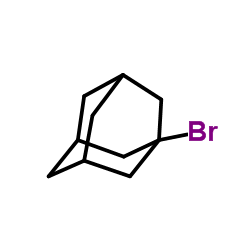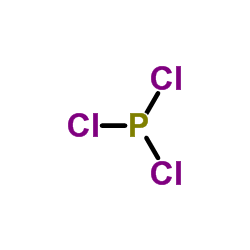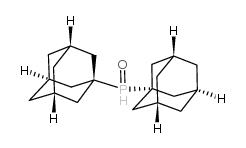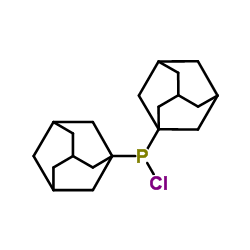126683-99-6
| Name | 1-[1-adamantyl(chloro)phosphoryl]adamantane |
|---|---|
| Synonyms |
Diadamantan-1-ylphosphinic chloride
Di-1-adamantylphosphinsaeurechlorid Phosphinic chloride, P,P-ditricyclo[3.3.1.1]dec-1-yl- DI-1-ADAMANTYLPHOSPHINIC CHLORIDE |
| Density | 1.2±0.1 g/cm3 |
|---|---|
| Boiling Point | 498.0±12.0 °C at 760 mmHg |
| Melting Point | 214ºC |
| Molecular Formula | C20H30ClOP |
| Molecular Weight | 352.878 |
| Flash Point | 255.0±19.6 °C |
| Exact Mass | 352.172272 |
| PSA | 26.88000 |
| LogP | 5.01 |
| Appearance | crystal | white |
| Vapour Pressure | 0.0±1.2 mmHg at 25°C |
| Index of Refraction | 1.570 |
|
Section 1: Product Identification Chemical Name:Di-1-adamantylphosphinic chloride, 98% CAS Registry Number:126683-99-6 Formula:(C10H15)2POCl EINECS Number:none Chemical Family:organophosphine ligand Synonym:Di-1-adamantylchlorophosphane
Section 2: Composition and Information on Ingredients IngredientCAS NumberPercentACGIH (TWA)OSHA (PEL) Title compound126683-99-6100%no datano data Section 3: Hazards Identification Emergency Overview:Irritating to skin, eyes and respiratory tract. Primary Routes of Exposure:Inhalation, skin, eyes. Eye Contact:Dust causes moderate to severe irritation of the eyes. Skin Contact:Causes moderate to severe irritation of the skin. May cause redness, itching and pain. Inhalation:Dust is irritating to the nose, mucous membranes and respiratory tract. Ingestion:No specific information is available on the physiological effects of ingestion. May be harmful if swallowed. Acute Health Affects:Irritating to skin, eyes and respiratory tract. Chronic Health Affects:No information on long-term chronic effects. NTP:No IARC:No OSHA:No SECTION 4: First Aid Measures Immediately flush the eyes with copious amounts of water for at least 10-15 minutes. A victim may need Eye Exposure: assistance in keeping their eye lids open. Get immediate medical attention. Wash the affected area with water. Remove contaminated clothes if necessary. Seek medical assistance if Skin Exposure: irritation persists. Remove the victim to fresh air. Closely monitor the victim for signs of respiratory problems, such as difficulty Inhalation: in breathing, coughing, wheezing, or pain. In such cases seek immediate medical assistance. Seek medical attention immediately. Keep the victim calm. Give the victim water (only if conscious). Induce Ingestion: vomiting only if directed by medical personnel. SECTION 5: Fire Fighting Measures Flash Point:no data Autoignition Temperature:no data Explosion Limits:no data Extinguishing Medium:carbon dioxide, dry powder or foam. Fire fighters should be equipped with a NIOSH approved positive pressure self-contained breathing apparatus Special Fire Fighting Procedures: and full protective clothing. Hazardous Combustion andIf involved in a fire this material may emit toxic organic fumes. Decomposion Products: Unusual Fire or Explosion Hazards: No unusual fire or explosion hazards. SECTION 6: Accidental Release Measures Spill and Leak Procedures:Small spills can be mixed with powdered sodium carbonate or ground limestone and swept up. SECTION 7: Handling and Storage Handling and Storage:Store the material in a cool, dry place in a tightly sealed container. Handle under a dry atmosphere. SECTION 8: Exposure Controls and Personal Protection Eye Protection:Always wear approved safety glasses when handling a chemical substance in the laboratory. Skin Protection:Wear protective clothing and gloves. Ventilation:Handle the material in an efficient fume hood. If ventilation is not available a respirator should be worn. The use of respirators requires a Respirator Respirator: Protection Program to be in compliance with 29 CFR 1910.134. Ventilation:Handle the material in an efficient fume hood. Additional Protection:No additional protection required. SECTION 9: Physical and Chemical Properties Color and Form:white xtl. Molecular Weight:352.88 Melting Point:214° Boiling Point:no data Vapor Pressure:no data Specific Gravity:no data Odor:not determined Solubility in Water:insoluble SECTION 10: Stability and Reactivity Stability:moisture sensitive Hazardous Polymerization:no hazardous polymerization Conditions to Avoid:none Incompatibility:oxidizing agents and halogens Decomposition Products:carbon monoxide, carbon dioxide, hydrogen chloride, organic fumes and phosphorus pentoxide. SECTION 11: Toxicological Information RTECS Data:No information available in the RTECS files. Carcinogenic Effects:no data Mutagenic Effects:no data Tetratogenic Effects:no data SECTION 12: Ecological Information Ecological Information:No information available SECTION 13: Disposal Considerations Disposal:Dispose of according to federal, state, and local regulations. SECTION 14: Transportation Shipping Name (CFR):Non-hazardous Hazard Class (CFR):NA Additional Hazard Class (CFR):NA Packaging Group (CFR):NA UN ID Number (CFR):NA Shipping Name (IATA):Non-hazardous Hazard Class (IATA):NA Additional Hazard Class (IATA):NA Packaging Group (IATA):NA UN ID Number (IATA):NA SECTION 15: Regulatory Information TSCA:Not listed in the TSCA inventory. SARA (Title 313):Title compound not listed. Second Ingredient:none SECTION 16 - ADDITIONAL INFORMATION N/A |
| HS Code | 2903890090 |
|---|
|
~93% 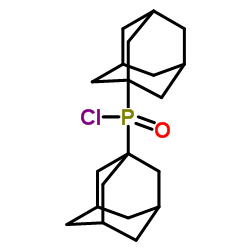
126683-99-6 |
| Literature: No, B. I.; Zotov, Yu. L.; Karev, V. N. J. Gen. Chem. USSR (Engl. Transl.), 1990 , vol. 60, # 8.1 p. 1795 - 1799,1603 - 1606 |
|
~87% 
126683-99-6 |
| Literature: Yurchenko, R. I.; Peresypkina, L. P.; Miroshnichenko, V. V.; Yurchenko, A. G. Russian Journal of General Chemistry, 1993 , vol. 63, # 7.1 p. 1072 - 1076 Zhurnal Obshchei Khimii, 1993 , vol. 63, # 7 p. 1534 - 1539 |
|
~95% 
126683-99-6 |
| Literature: Beller, Matthias; Ehrentraut, Andreas; Ehrentraut, Wilhelm Hubert; Ehrentraut, Theresia Elisabeth; Fuhrmann, Christa; Zapf, Alexander Patent: US2004/68131 A1, 2004 ; |
|
~87% 
126683-99-6 |
| Literature: Yurchenko, R. I.; Peresypkina, L. P. J. Gen. Chem. USSR (Engl. Transl.), 1992 , vol. 62, # 10.2 p. 2389 - 2390,1971 |
|
~44% 
126683-99-6 |
| Literature: Yurchenko, A. G.; Fedorenko, T. V.; Titova, M. I.; Yurchenko, R. I.; Voitsekhovskaya, O. M. J. Gen. Chem. USSR (Engl. Transl.), 1989 , vol. 59, # 10.1 p. 2212 - 2217,1982 - 1986 |
| Precursor 7 | |
|---|---|
| DownStream 3 | |
| HS Code | 2903890090 |
|---|---|
| Summary | 2903890090. halogenated derivatives of cyclanic, cyclenic or cyclotherpenic hydrocarbons. VAT:17.0%. Tax rebate rate:13.0%. . MFN tariff:5.5%. General tariff:30.0% |

